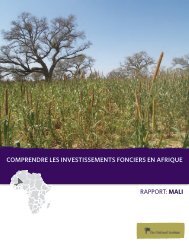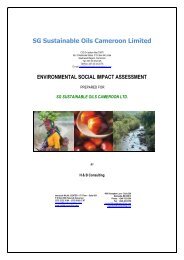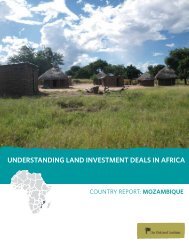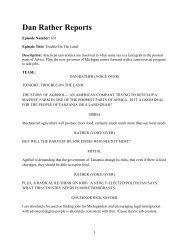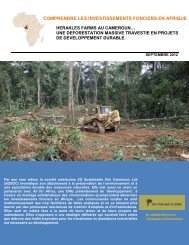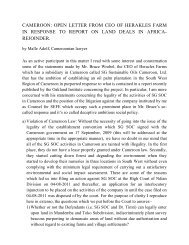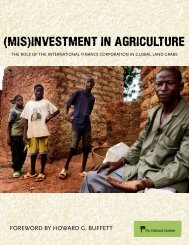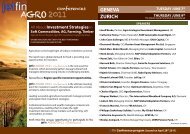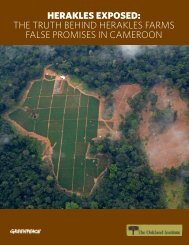P O L I C Y B R I E F - Oakland Institute
P O L I C Y B R I E F - Oakland Institute
P O L I C Y B R I E F - Oakland Institute
Create successful ePaper yourself
Turn your PDF publications into a flip-book with our unique Google optimized e-Paper software.
$725 million on research and developmentwhile earning a net profit of $689 million. 32005 alone, the global biotechnology industryracked up a collective loss of $4.3 billion. 12This is the product development Agricultural biotechnology is hemorrhagingmodel that has become institutionalized in thepharmaceutical industry. Companies spend bigfor several years in the hopes of coming upwith a single blockbuster drug that will generateenough revenue to cover all their sunk costs whiledelivering a handsome profit. 4 This may be asustainable business model for the pharmaceuticalindustry considering the huge size of the market– the world spent $550 billion on drugs in 2004 5– but it hardly makes sense when addressing thetraditionally low margin seed business. “Compareagriculture to pharmaceuticals; any new drug thatmoney because they have invested enormoussums in cheap commodities – seeds – whosegenetically engineered, value-added componentsoffer negligible advantages over conventionalvarieties. Agriculture is an industry marked bylow-margin products, high development costs,and long lead times. 13 It is not a blockbusterbusiness and never will be because investing inproducts that augment farm production results inan inescapable contradiction: the demand for foodis inelastic; fluctuations in price are unlikely to bemet by changes in the frequency of consumption.improves a patient’s health,no matter how slightthe effect, can be worthbillions. In agriculture, anew gene has to have theeffect of a sledgehammer orno one will notice.” 6 Pfizer,Agricultural biotechnology hasbeen financed by the promiseof future profits from productsunrelated to food.This phenomenon, oftensimply referred to asthe “fixed stomach,”means that when suppliesincrease and food pricesfall, consumers do notnecessarily buy moreMonsanto’s parent company, made $12.9 billion in groceries and eat more food. 142006 from a single drug, Lipitor, 7 an amount doubleDecades of agricultural innovationthe revenue of the entire market for GE seeds. 8Agricultural biotechnology has beenfinanced by the promise of future profits fromproducts unrelated to food. As Daniel Charlesnotes in Lords of the Harvest, “Few, if any,companies that heavily invested in biotechnologyfor agriculture have recovered that investmenthave resulted in a long decline in internationalfood prices as production has grown faster thandemand. 15 In the United States, between 1913and 1996 the real cost of food at retail leveldeclined 35 percent. 16 The food processingindustry is enormously profitable but they arenot directly engaged in agriculture. The industrythrough sales of genetically engineered simply exploits their market position as theproduct.” 9 And this observation extends tothe biotechnology industry as a whole. In itsalmost 30 year history, the industry has neverbeen profitable. 10 During this time, the biotechindustry has sustained cumulative net lossesof more than $40 billion while investorsmiddle man between farmers and consumers,buying cheap and selling dear. 17 But the valueof seeds is capped by the value of the foods theywill become. Farmers will not spend more onseeds than they expect to recoup from the sale oftheir crops.bought close to $100 billion in stock. 11 In2w w w . O A K L A N D I N S T I T U T E . o r g
Seed R&D as a Means toMonopolizing Genetic ScienceThe meager returns from seed sales hardly matterto the giant pharmaceutical conglomerates. Foodis merely a conduit through which they hope todevelop and monopolize the basic technologiesthat will then be used to create more valuableproducts. As David Goodman et al. note intheir groundbreaking work From Farming toBiotechnology, “The ultimate prize is dominationand proprietary ownership of the scientificknowledge and process engineering technologyrequired to control the complex biological reactionsand microbial activities.” 18 These “proprietarytechnology platforms . . . have become the endproducts themselves” 19 because controlling theenabling technology is more important thanowning the genetic material itself. 20 In the wordsof the former CEO of Monsanto, Robert Shapiro,“We are learning about biology at a level and ata rate that is absolutely unprecedented in humanhistory. There is an enormous space to be filled,and the stakes are very high. We want to be able tooccupy and hold the most valuable territory.” 21Leading firms such as Monsanto, Novartis,and DuPont have sought to “develop and amasspatent portfolios that are broad enough to barentry by new players and deep enough in terms oftheir control over basic technologies to give themsubstantial economic power in key markets.” 22 Ina study entitled Impact of Industry Concentrationon Innovation in the U.S. Plant Biotech Industrypublished in 2000, the authors found that thelargest firms have been enormously successfulin pursuit of these goals. Analysis shows thatnew firm entry in the “innovation market” isdeclining, and research and investment is fallingin all but the top four firms. 23 Entry into the field ofbiotechnology is becoming increasingly difficult,as the major players jockey for position. To takebut one example, in the early 90’s Agracetus wasgranted a patent covering all transgenic cotton.Since then, anyone making any kind of geneticmodifications to cotton must seek permission fromand pay royalties to Agracetus. 24The pharmaceutical conglomeratesare investing disproportionately large sums inagricultural biotechnology because recent findingsindicate that different species share similar geneconstructs. For example, we share 99 percent ofour genome with chimpanzees and 31 percent ofour genes are interchangeable with those of yeast. 25This discovery has given birth to projects suchas the National Plant Genome Initiative whichintroduced the term “reference species” to suggestthat the genomic map of a single plant speciesmight serve as a “reference” for decoding thegenomes of other plant species and maybe evenhumans. 26 As William Boyd explains in his bookchapter “Wonderful Potencies: Deep Structureand the Problem of Monopoly in AgriculturalBiotechnology,”The sequences of model organisms . . . areintended to provide the Rosetta stone of sortsfor interpreting the genomes of more complexorganisms. Genomics thus holds out the promiseof a grand unification in biology, providing thekey to the basic processes of gene function andprotein synthesis common to all organisms. 27Biotechnology’s PromiseBiotechnology’s promise began to pay out in1978, a landmark year for the industry. Genentechannounced that it had, for the first time in history,manufactured a human protein outside of thehuman body. The company had successfullymanaged to coax insulin from an E. coli bacterium3
y splicing human genetic instructions into itsintracellular workings.Today there are over 30 protein-basedmedicines on the market and an additional 371in the research and development phase. 28 Everyone of these new drugs has been made possibleby advances in recombinant DNA processes andtechniques. The only problem for the industry isthat using single cells to produce biotech drugs,also known as biologics, is a complicated andtime-consuming process. 29 These hybrid cellsmust be fermented or cultured in enormous10,000 liter “bioreactor” stainless steel tanks.This presents difficultiesfor the smooth circulationof capital through theproduction process. Abiotech production facilitycan cost upwards of $400million and take three tofive years to complete. Inaddition, the geneticallyengineered cells will onlyproduce the target proteinsif precise conditions are maintained. If thetemperature, oxygen, acidity, or other variables inthe bioreactor are not stable, the culture will fail.And finally, certain compounds are too complexto be manufactured using single cells.The complications of biologics havepushed the pharmaceutical industry to pursuethe promise of biotechnology in the figure of“pharming”. Pharming, a coined term combining“farming” and “pharmaceutical,” is the practicewhereby genetic material from a foreign speciesis inserted into a plant or animal with the expressintent of extracting novel pharmaceuticalproducts from the resulting tissues, fluids, andorgans. From 1991 to 2004 over 300 field sitesencompassing hundreds of acres of land 30 and anunknown number of animals, estimated to be inthe thousands, were pharmed. The pharmaceuticalconglomerates are investing in pharming becausethey anticipate that products that they cannotphysically or affordably engineer mechanicallymay become feasible when the task is delegatedto genetically engineered plants and animals. 31For example, Mich Hein, the president of Epicyte,claims that his company’s plant-based productiontechnology can make the same annual quantity ofdrugs with 200 acres of corn and a few milliondollars in expenses that a $400 million factory canproduce using a mammalian cell-based system. 32Pharming isthe ultimate pursuitfor those companiesperforming researchand development inthe field of agriculturalbiotechnology. Billionsof dollars have beeninvested in agriculturalbiotechnology, not toensure more food ormore nutritious food for the hungry, but to selllonger lives to the wealthy. Because as RobertFraley, the executive vice president and chieftechnology officer at Monsanto, observes:Soon, a few animals in alaboratory will be more valuablethen all the livestock in all thecoops, pens, and stockyards ofthe world. Think geneticallyengineered pigs incubatinghuman hearts. 34There’s a limit to the genes that simply helpfarmers grow the same old commodities . . .They’re limited by the value of those crops. Butthink of genes that actually make the harvest morevaluable! What if plants could be engineered toproduce new products: oils, nutrients, or evenpharmaceuticals for which consumers would payhigh prices? 33 The FDA does not make this information publiclyavailable.4w w w . O A K L A N D I N S T I T U T E . o r g
Soon, a few animals in a laboratory willbe more valuable then all the livestock in all thecoops, pens, and stockyards of the world. Thinkgenetically engineered pigs incubating humanhearts. 34 In fact, flocks of sheep with partiallyhuman hearts, livers, and brains are already areality on a farm operated by the University ofNevada just miles outside Reno. 35Ancient alchemists dreamed oftransmuting base metals into gold, discoveringa universal cure for disease, and indefinitelyprolonging life. Biotechnologists have inheritedthis dream, promising to convert soil andsunlight into the building blocks of human life.Disturbingly, our food has become a casualty ofthis promise. Seventy percent of the grocerieson US supermarket shelves now contain GEingredients 36 not because GE seeds are higheryielding or bear more nutritious crops then theirconventional counterparts (under many growingconditions GE crops actually exhibit yield dragand are less nutritious). 37 Our food containsGE ingredients because single-trait geneticmanipulations of corn and soybean plants arethe foundations from which more significantinterventions in human genetics are beinglaunched.Propping up the Biotech MarketFood has become a casualty of biotechnology’spromise because the agricultural sectoroffers pharmaceutical conglomerates uniqueopportunities to pursue the development andmonopolization of proprietary biotechnologyplatforms while reducing their financial risks. Theenormous public resources invested in agriculturehave benefited these companies by promoting thesale of GE seeds over and above their actual valueand by allowing them to multiply their researchefforts at minimal cost through collaborations withpublic institutions. I am specifically referring to herbicide-tolerant andinsect-resistant GE seeds. Together these two traitsconstitute nearly the entire market for GE seeds.5
Over the course of the last century, farminghas become increasingly capital intensive. Discreteelements of the agricultural production processhave continually been displaced from farm fields,deconstructed in laboratories, reconstructed inmanufacturing facilities, and reincorporated backinto agriculture as purchased inputs. 38 Resourcesthat were formerly sourced and supplied by thefarm have been replaced by industrial equivalents.These changes in the structure and operation ofAmerican farms did not occur entirely of theirown accord. Rather, they are the consequence ofgovernment policies that have promoted capitalaccumulation in the agricultural sector.In 2000, nearly 50 percent of U.S. farmsreceived payments for income or price support.These payments, comprising almost one-half ofnet farm income, reached a historic high of $20billion that year. 39 Most of the payments farmersreceive from the government are compensationfor the difference between their high costs ofproduction and the low market price. For example,in 2000 it cost farmers an average of $2.72 to growa bushel of corn, while the market price was only$1.77. 40 Government payments largely coveredthe difference, helping to maintain farm solvencyin the face of massive overproduction and rockbottom prices. As a result, farmers continue to pushtheir yields, increasing both the absolute volumeof inputs and the technological sophistication ofthose inputs, knowing that the expenses they incurwill be covered by the generosity of Uncle Sam.That is, government support for commodity pricesultimately translates into government support forindustrial inputs.Industry sales are then further reinforced bytax policies: tax credits, accelerated depreciation,the special treatment of capital gains, all of whichstimulate investment in agriculture by loweringthe cost of capital. 41 These policies are thencomplemented by government-backed financialinstitutions such as the Farm Credit System andthe Farmers Home Administration that lend tofarmers at highly subsidized interest rates, therebyencouraging excessive capital investment foroperating inputs. 42The bottom line is that industry has thegovernment to thank for its sales. Governmentsupported commodity prices, tax breaks oncapital goods, and cheap credit translate intogreater demand for manufactured inputs. Theseinterventions have made it possible for agribusinessto sell products to farmers that actually increasetheir losses. (If it costs $2.72 to raise a bushelof corn for which you receive $1.77, the moreyou produce the more you lose). But so long astaxpayer funds can be used to foot the bill forthese technologies and purchase the excess theygenerate at premium prices, farmers will continueto demand them.Unfortunately, farmers are not the primarybeneficiaries of federal largesse. For as Jeanne-Pierre Berlan calls to our attention, the “ideaupon which modern agricultural policies werefounded never intended to defend the familyfarm but to foster capital accumulation in theemerging agribusiness complex increasinglydominated by large corporations.” 43 Farm receiptsas a percentage of total farm household incomecontinue to fall and most farmers are forced to findoff-farm work to make ends meet. 44 The fact ofthe matter is, the money we fork over as taxpayerseventually ends up in the pockets of agribusiness(strangely enough agribusiness now includes thepharmaceutical industry). It is with this in mindthat we should evaluate the success of GE seeds,an invention whose adoption is largely attributableto government subsidies.6w w w . O A K L A N D I N S T I T U T E . o r g
Priming the Biotech PipelineThe government essentially promotes the sale ofGE seeds; that is, so to speak, the demand side ofthe equation. On the supply side, universities andpublic research institutions enter into the analysis.The Harvard zoologist Richard Lewontin sums itup best when he notes:the costs of long-range research are socialized bychanging the locus of the work from individualenterprises [i.e. pharmaceutical companies] topublic institutions such as universities and nationalinstitutes. In this way, by tax subsidization, noindividual firm need risk an investment and thetotal costs are spread over the entire tax base.[Then, when] such socialized research comesclose to producing a marketable product, the finaldevelopment stages are taken back into privatehands to realize an exclusive property. 45Through their collaborations with public researchinstitutions, the biotechnology industry hasmanaged to reorient science, affecting whatquestions will be asked, which problems will beinvestigated, what solutions will be sought, andwhat conclusions will be drawn. 46 As researchfunding from federal and state sources continuesto stagnate while universities seek to expandtheir research facilities, 47 they have progressivelybecome more and more willing to entertain thedesigns of industry.At State Agricultural Experiment Stationsand Land-Grant Universities, the “lure of largesums of private money for biotechnology researchhave led to a change in disciplines,” as staffconducting agricultural biotechnology researchhave increased substantially at the expense ofconventional breeding programs. 48 Throughmonetary enticements, private firms have managedto leverage their relatively minor financialcontributions throughout the university or institute,thereby capturing within their orbit human andlaboratory resources that are primarily sustainedthrough public funding. A strategy reinforcedby tax deductions: in California, the center ofthe biotechnology industry in the United Statesand home to the expansive and well-endowedUniversity of California educational system,thereis a 24 percent tax credit for business investmentsin university research. 49Federal legislation encouraging publicprivatepartnerships and the patenting of universitygenerated knowledge also serves to disciplinepublic research to the pursuit of private profits.In 1974, prompted by Stanford University’spetition to patent the Cohen-Boyer recombinantDNA process, the National <strong>Institute</strong>s of Healthdecided to allow “universities to patent andlicense in the field of genetic engineering” greatlysimplifying “the privatization of universityresearch by removing any claims on behalf of thepublic regarding ownership of government-fundedresearch.” 50 Most large research universities nowhave Offices of Technology Transfer (OTT)to facilitate cooperation between corporationsand university researchers. 51 A developmentencouraged by the 1980 Bayh-Dole Act whichofficially made it legal for public universitiesto patent inventions, established frameworks tofacilitate technology transfer from the public to theprivate sector, and made it possible for universitiesto go into business for themselves. Since then,universities have formed hundreds of startupcompanies “based on technology they developedand licensed” 52 – companies wherein facultymembers frequently sit on the board serving as“advisers, recruiters of trained personnel, andinformation sources on current developmentsin academic science”. 53 A development which7
offers these companies a foothold in the academyand assures that university research will becommercialized on industry’s terms.Normalizing BiotechnologyIn addition to the financial advantages theagricultural sector offers the pharmaceuticalconglomerates, there are ethical advantagesto transforming the farm into biotechnology’sfrontier. The commercialization of geneticallyengineered corn, cotton, and soybeans introducesthe world to biotechnology, yet these productsinsinuate themselves into our lives largelyunnoticed because they are not primarily forhuman consumption and are not animate in waysthat normally invite anthropomorphism. Contrastsociety’s general acceptance of GE corn, cotton,and soybeans with GE wheat: Monsanto’s plansto introduce Roundup Ready wheat have beenrepeatedly delayed as farmers continue to expressconcern over consumer acceptance of a product thatis largely for human consumption. 54 Consider alsothe reaction to GE animals: although the animalbiotechnologies were “developed as early as the Only a tiny fraction of the millions of bushels ofcorn and soybeans grown in the United States areconsumed by humans. Most is fed to livestock andmuch of the remainder is incorporated into industrialproducts. The corn and soybeans we do consume isusually a fractionated component of the whole food,i.e. high fructose corn syrup, lecithin, vegetable oil etc.plant biotechnologies . . . they have taken longer tocome to fruition because of greater scientific andregulatory challenges.” 55 Transgenic pigs weredeveloped as early as 1986 but as of this writingnot a single biotech animal has been approvedfor commercial sale. But with corn, cotton, andsoybeans, the pharmaceutical industry founda secure space within the regulatory networksof agriculture that grants them carte blancheto genetically manipulate and commercializecomplex organisms. This is a crucial next step,after the microbe and the single cell, in the questfor proprietary technology platforms that will beused to develop the next generation of health careproducts: plant and animal derived human proteinsand human organs.Thus, a clear pattern emerges: the taxes wepay have supported the failures of biotechnology,increasing the demand for GE seeds throughgovernment supports, subsidizing their supplythrough public research, and helping to create aregulatory framework in which these productsmight receive society’s stamp of approval. Allthis has been done in the name of creating a more Although GE animals have not been approved forcommercial sale, due to negligence hundreds haveended up in the food supply. For one instance amongmany see: FDA. “FDA investigates improper disposalof bioengineered pigs”. February 5, 2005. (Availableat http://www.fda.gov/bbs/topics/ANSWERS/2003/ANS01197.html)8w w w . O A K L A N D I N S T I T U T E . o r g
productive agriculture. These claims are a smokescreen for the development and monopolizationof proprietary biotechnology platforms, whichultimately will be deployed toward more profitableends than making more corn. EpilogueIn the 1940’s, when grain yields per acre startedto increase dramatically in the United States andcontinued to rise for decades, observers labeledthe phenomenon the “Green Revolution.” Theincreased productivity of the Green Revolutionwas based on the breeding efforts of scientists whoscoured the world for plant traits that would benefitfarmers – stiffer stalks, bulkier heads, resistanceto disease, etc. These traits were discovered infarmers’ fields but were not collectively presentin any one single plant, so breeders took up thetask of incorporating them into new seeds. Theseseeds promised higher yields, but something waslost along the way. Plants grown from these seedswere not as well adapted to their environment.They would fail to perform as expected unlesssupported by insecticides, herbicides, fertilizers,and irrigation – technologies which recreatedthe controlled environmental conditions of thelaboratory.The Green Revolution sent a messageto farmers: “If you want to increase your yieldsyou must recreate our laboratory in your fields;you must replace your seeds with our seeds andinstitute our methods in place of your own.” 56More than anything else the Green Revolution was At any one point in time the United States has morecorn in storage than the 450 million people who makeup the European Union consume, for all purposes, inan entire year. In total, the US has more corn sittingin silos than the next 10 countries combined. (ForeignAgricultural Service, USDA. “World Corn Production:Consumption and Stocks”)a revolution in the power of laboratories over theindependence of farmers. This power emanatesfrom the laboratory’s ability to bind together actorssituated beyond the laboratory into networks thatemploy and deploy the scientific facts and artifactsthat they have generated. 57 When farmers adoptedthe technologies of the Green Revolution, theybecame part of this laboratory network. However,as dictated by the structure of the network, theydid not share equally in its reward. Rather, theybecame dependent on technologies that they couldnot reproduce, that replaced their own resources,and that emanated from a remote center overwhich they had little control.The so called “Gene Revolution,” a termused to encompass the impact of biotechnology onagriculture, simply represents the latest frontierin the laboratory’s struggle to subject farms andfarming to the logic of capital. The space whereinthe productivity of agriculture will be enhanced– the genome – is inaccessible to farmers eventhough it exists in their fields and sheds.This is a dangerous development, forbiotechnology is subject to tunnel vision. “Modernbiology attempts to reduce nature to small,definable pieces, subject to human manipulation,and separated from broader questions of value.From this perspective, scientists control, measure,reduce and divide nature in order to generateknowledge.” 58 But these methods alone are notconducive to a healthy and productive agriculture.Agricultural biotechnology is based on the premisethatfarming brings the farmer annually, over andover again, to the same series of problems,to each one of which there is always the samegeneralized solution . . .. But that is false . . ..neither the annual series of problems nor any ofthe problems individually is ever quite the sametwo years running.” 599
The inherent variability of farming from oneplace and time to another necessarily frustrates aone size fits all approach. 60 Yet with each passingyear, the institutions we rely on for innovativeagricultural solutions are more tightly yoked toa reductionist science whose frames of referencediminish the importance of holistic methods ofinquiry. “As a consequence whole-plant- andwhole-animal-level research (such as traditionalbreeding), systems-level research programs(such as agroecology, farming systems and socialassessments), and indigenous knowledge . . . lackadequate support.” 61To honestly address the problems facingagriculture today this trend must be reversed. Wecannot stand inert while the agricultural researchagenda is perverted by biotechnology’s promise,while resources earmarked for agriculture arediverted and deployed to shore up the finances ofthe pharmaceutical industry. Public universitiesand government institutions are financially andmorally obligated to serve the public interest.They are accountable to us and we must hold themto it. Collaborations between public institutionsand private companies should be scrutinized toensure that the public interest comes before privateprofits. Federal farm subsidies that encouragefarmers to adopt capital-intensive productiontechnologies that displace their own skills andlocal resources must be disassembled. Our currentmodel of farm support that distorts the market forfarm commodities, bankrupts farmers, fouls theenvironment, and offers the consumer pesticidelacedproduce must be abandoned. A brighterfuture for farming is possible.Acknowledgements: Many thanks to AnuradhaMittal, Melissa Moore, and Becky Tarbotton fortheir conceptual and editorial support and toDaniel Heimbinder whose ink and watercolorillustrations grace these pages.Online ActionTo learn more and get involved check out theseonline resources:• www.eraction.org: Environmental Rights Action(ERA), the Nigerian chapter of Friends of theEarth International, is challenging the biotechpush to promote “Medicine Rice” in Africa.• www.ucsusa.org: The Union of ConcernedScientists, a science-based nonprofit workingfor a healthy environment, is campaigning toban the outdoor use of food crops to producepharmaceuticals and industrial chemicals.• www.biosafety-info.net: The Biosafety InformationCenter, run by the Third World Network,provides up to date information regardingbiosafety policies, laws, and practices at theinternational, regional, and national levels.• www.centerforfoodsafety.org: The Center forFood safety works to protect human health andthe environment by curbing the proliferation ofharmful food production technologies.• www.etcgroup.org: The ETC Group is awatchdog organization whose hard hittingreports on genetic engineering, nanotechnology,agriculture, and the environment unveil themachinations behind our meals.• www.organicconsumers.org: The OrganicConsumers Association campaigns in supportof food safety, children’s health, corporateaccountability, fair trade, and environmentalsustainability. Join their “Million AgainstMonsanto” campaign today.• www.calgefree.org: Californians for GE FreeAgriculture supports the rights of farmersand communities to evaluate and address theenvironmental, human health, and economicrisks of genetic engineering in agriculture.10w w w . O A K L A N D I N S T I T U T E . o r g
NOTES1 Charles, Daniel. Lords of the Harvest: Biotech, Big Money,and the Future of Food Cambridge, MA: Perseus Publishing,2001. p. xv.2 Stone, Glen Davis. “Both Sides Now: Fallacies in the GeneticModification Wars, Implications for Developing Countries,and Anthropological Perspectives.” Current Anthropology.43(2002): 611-630.3 Monsanto. “Monsanto Company 2006 Annual Report.” 2006.p. 74. (Available at http://www.monsanto.com/monsanto/content/investor/financial/reports/2006/2006AnnualReport.pdf)4 Bergeron, Bryan P., and Paul Chan. Biotech Industry: AGlobal, Economic, and Financing Overview. Hoboken, NJ:J. Wiley, 2004. p. 175.5 The Economist. “An Overdose of Bad News.” March 17,2005. (Available at http://www.economist.com/printedition/displayStory.cfm?Story_ID=3764524)6 Charles, Daniel. Lords of the Harvest: Biotech, Big Money,and the Future of Food. p. 297.7 Pollack, Andrew. “Pfizer, Hurt by Rival Generic Drugs, WillLay Off 7,800.” The New York Times. January 23, 2007.8 Davoudi, Salamander. “Monsanto: giant of the 6.15 bn GMmarket.” Financial Times. November 16, 2006.9 Charles, Daniel. Lords of the Harvest: Biotech, Big Money,and the Future of Food. p. 295.10 Ernst & Young. “Beyond Borders: The GlobalBiotechnology Report 2006.” Ernst & Young. (Available athttp://www.ey.com/global/Content.nsf/International/Media_-_Press_Release_-_Beyond_Borders_2006)11 Agres, Ted. “US Biotech may Leap into the Black.” DrugDiscovery and Development. (Available at http://www.dddmag.com/ShowPR.aspx?PUBCODE=016&ACCT=1600000100&ISSUE=0407&RELTYPE=PR&ORIGRELTYPE=PNP&PRODCODE=00000000&PRODLETT=X)12 Ernst & Young. “Beyond Borders: The GlobalBiotechnology Report 2006.”13 Jefferson, Richard A. “Transcending Transgenics: Arethere ‘Babies in the Bathwater’ Or is that a Dorsal Fin?”The Future of Food: Biotechnology Markets and Policies inan International Setting. Ed. Philip G. Pardey. Washington,D.C.: International Food Policy Research: distributed by theJohns Hopkins University Press, 2001. p. 95.14 Pollan, Michael. The Omnivore’s Dilemma: A NaturalHistory of Four Meals. New York: The Penguin Press, 2006.p. 94.15 Watts, Michael, and David Goodman. “Agrarian Questions:Global Appetite, Local Metabolism: Nature, Culture, andIndustry in Fin-De-Siecle Agro-Food Systems.” GlobalisingFood: Agrarian Questions and Global Restructuring. Ed.David Goodman and Michael Watts. London ; New York:Routledge, 1997. p. 12.16 Gardner, Bruce L. American Agriculture in the TwentiethCentury: How it Flourished and What it Cost. Cambridge,MA: Harvard University Press, 2002. p. 141-142.17 Magdoff, Fred, John Bellamy Foster, and Frederick H.Buttel. “An Overview.” Hungry for Profit: The AgribusinessThreat to Farmers, Food, and the Environment. Ed. FredMagdoff, John Bellamy Foster, and Frederick H. Buttel. NewYork: Monthly Review Press, 2000. p. 11.18 Goodman, David, John Wilkinson, and Bernardo Sorj.From Farming to Biotechnology: A Theory of Agro-IndustrialDevelopment. New York: Basil Blackwell, 1987. p. 138.19 Scholz, Astrid J. “From Molecules to Medicines: Theuse of Genetic Resources in Pharmaceutical Research.”Engineering Trouble: Biotechnology and its Discontents. Ed.Rachel Schurman and Dennis D. Kelso. Berkeley: Universityof California Press, 2003. p. 201.20 Gaisford, James D. The Economics of Biotechnology.Cheltenham, UK ; Northampton, Mass.: Edward Elgar, 2001.p. 41.21 Quoted in Boyd, William. “Wonderful Potencies: DeepStructure and the Problem of Monopoly in AgriculturalBiotechnology.” Engineering Trouble: Biotechnology andits Discontents. Ed. Rachel Schurman and Dennis D. Kelso.Berkeley, CA: University of California Press, 2003. p. 52.22 Ibid., p. 44.23 Brennan, Margaret F., Carl E. Pray and Ann Courtmanche.“Impact of Industry Concentration on Innovation in the U.S.Plant Biotech Industry.” Transitions in Agbiotech: Economicsof Strategy and Policy. Washington, D.C., June 24-25, 1999.p. 153.24 Boyd, William. “Wonderful Potencies: Deep Structure andthe Problem of Monopoly in Agricultural Biotechnology.” p.43.25 Shreeve, Jamie. “The Other Stem-Cell Debate.” The NewYork Times Magazine. April 10, 2005.26 Gardner, John C., and Thomas L. Payne. “A SoybeanBiotechnology Outlook.” AgBioForum 6.1&2 (2003): 1-3. p.1.27 Boyd, William. “Wonderful Potencies: Deep Structure andthe Problem of Monopoly in Agricultural Biotechnology.” p.4328 Information in this paragraph was gathered from www.bio.org. The specific pages include “Advantages of Plants11
to Produce Therapeutic Proteins” (Available at http://www.bio.org/healthcare/pharmaceutical/pmp/factsheet3.asp) and“A Brief Primer on ManufacturingTherapeutic Proteins”(Available at http://www.bio.org/healthcare/pharmaceutical/pmp/factsheet1.asp)29 Ibid.30 Information Systems for Biotechnology. 2005. “Field testreleases in the U.S.” (Available at http://www.isb.vt.edu/cfdocs/fieldtests1.cfm)31 Elbehri, Aziz. 2005. “Biopharming and the food system:Examining the potential benefits and risks.” AgBioForum.8(1), 18-25. (Available at http://www.agbioforum.org/v8n1/v8n1a03-elbehri.htm)32 Van Brunt, Jennifer. “Molecular Farming’s Factories.”Signals: the online magazine of biotechnology industryanalysis. February 19, 2002. (Available at http://www.signalsmag.com/signalsmag.3764d93a977219f888256b640069e224?OpenDocument)33 Charles, Daniel. Lords of the Harvest: Biotech, Big Money,and the Future of Food. p. 193-194; Paraphrasing RobertFraley.34 For information concerning the race to develop geneticallyengineered animal organs for xenotransplanation tohumans, see: BBC. “Pig Cloning Race Hots Up.” January3, 2002. (Available at http://news.bbc.co.uk/2/hi/science/nature/1740879.stm)35 Associated Press. “Studies Mix Animal, Human organs.”April 30, 2005. (Available at http://www.foxnews.com/story/0,2933,155123,00.html)36 Wilson, William, Edward Janzen, and Bruce Dahl. “Issuesin Development and Adoption of Genetically ModifiedWheats.” AgBioForum 6.3 (2003): 101-12. p. 104.37 For information on yield drag in GE Soybeans see: Bohner,Horst. “What about Yield Drag on Roundup Ready Soybeans.”News Releases. Ontario Ministry of Agriculture, Food, andRural Affairs. March 2003. (Available at http://www.omafra.gov.on.ca/english/crops/field/news/croptalk/2003/ct_0303a9.htm) For information on the reduced nutrient content of GEsoybeans see: Lappé, Marc A., et al. “Alterations in ClinicallyImportant Phytoestrogens in Genetically Modified, HerbicideTolerant Soybeans.” Journal of Medicinal Food. 1.4 (1999).(Available at http://www.cetos.org/articles/abstract.html)38 Goodman, David, et al. From Farming to Biotechnology:A Theory of Agro-Industrial Development. p. 2.39 Government Accountability Office. Farm Programs:Information on Recipients of Federal Payments. Vol. GAO-01-606. Washinton, D.C.: GAO, 2001. p. 1.40 Benbrook, Charles. “A Bill of Goods: Agricultural Policy,Trade and Technology Innovation since the Mid-1990’s.”Upper Midwest Organic Farming Conference. LaCrosse,Wisconsin, February26-28, p. 13-14. (Available at http://www.biotech-info.net/MOSES.pdf)41 Atwood, Joseph A. “Implications of Tax Policy forFarm Structure.” Size, Structure, and the Changing Face ofAmerican Agriculture. Ed. Arne Hallam. Boulder: WestviewPress, 1993. p. 365.42 Gardner, B. Delworth. Plowing Ground in Washington:The Political Economy of U.S. Agriculture. San Francisco,Calif.: Pacific Research <strong>Institute</strong> for Public Policy, 1995. p.107.43 “The Historical Roots of the Present Agricultural Crisis.”Towards a New Political Economy of Agriculture. Ed.Friedland, William H. et al. Boulder, CO: Westview Press,1991. p. 127-128.44 Economic Research Service, USDA. “Farm Income andCosts: Farm Household Income.” (Available at http://www.ers.usda.gov/Briefing/FarmIncome/forenew.htm)45 Levins, Richard, and Richard C. Lewontin. The DialecticalBiologist. Cambridge, MA.: Harvard University Press, 1985.p. 201.46 Noble, David F. America by Design: Science, Technology,and the Rise of Corporate Capitalism. 1st ed. New York:Knopf, 1977. p. 147.47 Fuglie, Keith O. “Trends in Agricultural ResearchExpenditures in the United States.” Public-PrivateCollaboration in Agricultural Research: New InstitutionalArrangements and Economic Implications. Ed. Keith OwenFuglie and David Schimmelpfennig. 1st ed. Ames, IA: IowaState University Press, 2000. p. 12.48 Busch, Lawrence, Jeffrey Burkhardt, and William B. Lacy.Plants, Power, and Profit: Social, Economic, and EthicalConsequences of the New Biotechnologies. Cambridge, MA,USA: B. Blackwell, 1991. p. 193.49 Rausser, Gordon. “Public/Private Alliances.” AgBioForum2.1 (1999): 5-10. p. 9.50 Kenney, Martin. “Biotechnology and the Creation of aNew Economic Space.” Private Science: Biotechnology andthe Rise of the Molecular Sciences. Ed. Arnold Thackray.Philadelphia: University of Pennsylvania Press, 1998. p.134.51 Caswell, Margriet F., Keith Owen Fuglie, and Cassandra A.Klotz. Agricultural Biotechnology : An Economic Perspective.New York: Novinka Books, 2003. p. 14.12w w w . O A K L A N D I N S T I T U T E . o r g



